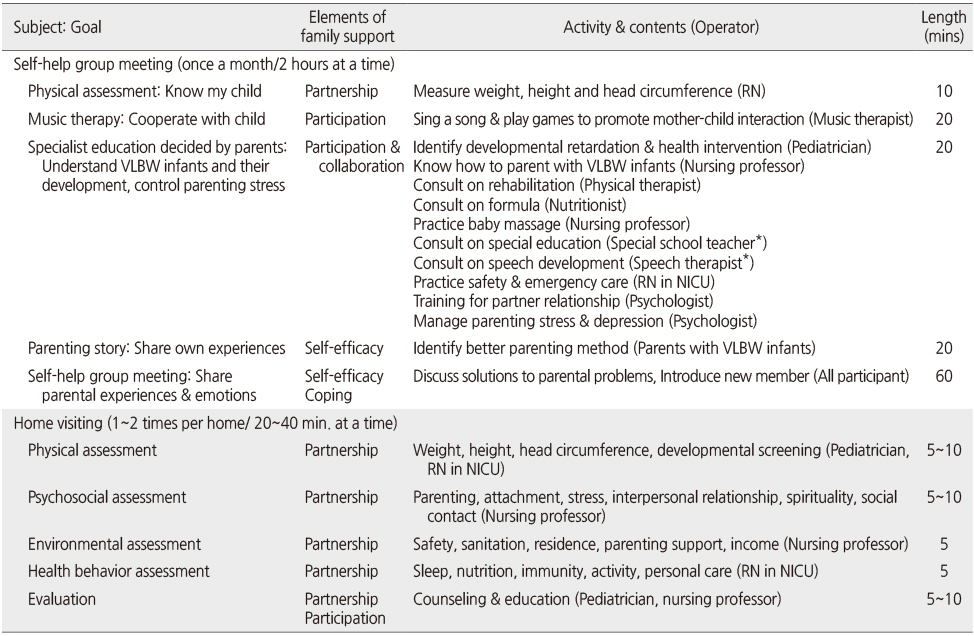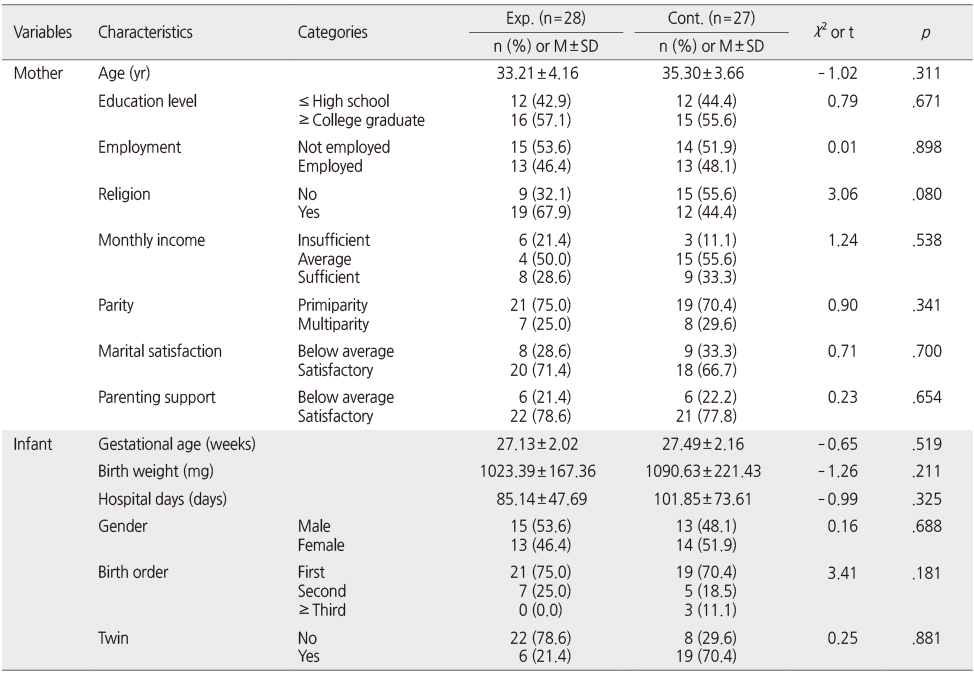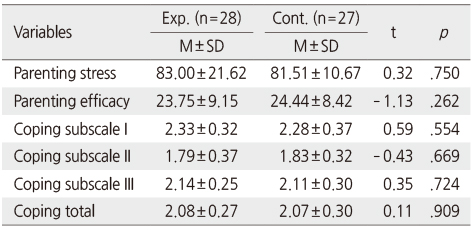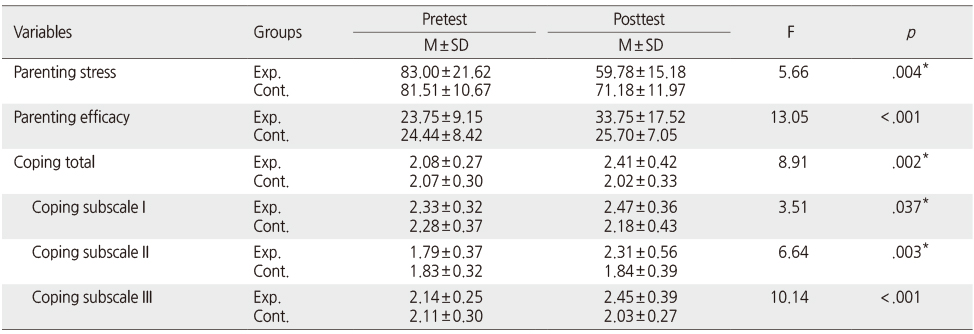Articles
- Page Path
- HOME > J Korean Acad Nurs > Volume 46(1); 2016 > Article
-
Original Article
- Effects of a Hospital Based Follow-Up Program for Mothers with Very Low Birth Weight Infants
- Min Hee Kim, Eun Sun Ji
-
Journal of Korean Academy of Nursing 2016;46(1):79-89.
DOI: https://doi.org/10.4040/jkan.2016.46.1.79
Published online: February 29, 2016
1Department of Pediatrics, KonKuk University Medical Center, Seoul, Korea.
2Department of Nursing, KonKuk University Glocal Campus, Chungju, Korea.
- Address reprint requests to: Ji, Eun Sun. Department of Nursing, KonKuk University Glocal Campus, 268 Chungwondae-ro, Chungju 27478, Korea. Tel: +82-43-840-3958, Fax: +82-43-840-3958, esji@kku.ac.kr
© 2016 Korean Society of Nursing Science
This is an Open Access article distributed under the terms of the Creative Commons Attribution NoDerivs License. (http://creativecommons.org/licenses/by-nd/4.0/) If the original work is properly cited and retained without any modification or reproduction, it can be used and re-distributed in any format and medium.
Abstract
-
Purpose
- This paper reports the results of a hospital centered follow-up program on parenting stress, parenting efficacy and coping for mothers with very low birth weight (VLBW) infants.
-
Methods
- The follow-up program consisted of home visiting by an expert group and self-help program for 1 year. A non-equivalent control group pre-post quasi-experimental design was used. Participants were 70 mothers with low birth weight infants and were assigned to one of two groups, an experimental groups (n=28), which received the family support program; and a control group (n=27), which received the usual discharge education. Data were analyzed using χ2-test, t-test, and ANCOVA with IBM SPSS statistics 20.0.
-
Results
- Mothers' parenting stress (F=5.66, p=.004) was significantly decreased in the experimental group. There were also significant increases in parenting efficacy (F=13.05, p<.001) and coping (F=8.91, p=.002) in the experimental group.
-
Conclusion
- The study findings suggest that a follow-up program for mothers with VLBW infants is an effective intervention to decrease mothers' parenting stress and to enhance parenting efficacy and coping.
- 1. Statistics Korea. Final results of birth statistics in 2014 [Internet]. Daejeon, Author. 2014;cited 2015 July 1. Available from: http://kostat.go.kr/portal/eng/pressReleases/8/10/index.board?bmode=read&aSeq=348278
- 2. Bae CW. Neonatal epidemiology in Korea: Statistics and clinical data. Seoul: Shinheung MedScience Inc.; 2012.
- 3. Marlow N, Hennessy EM, Bracewell MA, Wolke D. Motor and executive function at 6 years of age after extremely preterm birth. Pediatrics. 2007;120(4):793–804. ArticlePubMedPDF
- 4. Hwang HS, Kim HS, Yoo IY, Shin HS. Parenting stress in mothers of premature infants. Child Health Nurs Res. 2013;19(1):39–48. ArticlePDF
- 5. Im M, Oh J. Integrative review on caring education papers for parents with a premature infant. Child Health Nurs Res. 2013;19(2):120–129. ArticlePDF
- 6. Chon MY, Ji ES, Lee SH. Mothers' parenting experience of premature infants: Q methodological approach. J Korean Acad Nurs. 2013;43(6):704–713. ArticlePubMed
- 7. Park JY, Bang KS. Knowledge and needs of premature infant development and rearing for mothers with premature infants. Korean Parent Child Health J. 2013;16(1):17–26.
- 8. Choi HS, Shin YH. Effects on maternal attachment, parenting stress, and maternal confidence of systematic information for mothers of premature infants. Child Health Nurs Res. 2013;19(3):207–215. ArticlePDF
- 9. McCubbin HI, McCubbin MA, Patterson JM, Cauble AE, Wilson LR, Warwick W. CHIP-Coping health inventory for parents: An assessment of parental coping patterns in the care of the chronically ill child. J Marriage Fam. 1983;45(2):359–370.Article
- 10. McCubbin HI, McCubbin MA, Thompson AI, Han SY, Allen CT. Families under stress: What makes them resilient. J Fam Consum Sci. 1997;89(3):2–11.
- 11. Dunst CJ, Boyd K, Trivette CM, Hamby DW. Family-oriented program models and professional helpgiving practices. Fam Relat. 2002;51(3):221–229. Article
- 12. Meijssen DE, Wolf MJ, Koldewijn K, van Wassenaer AG, Kok JH, van Baar AL. Parenting stress in mothers after very preterm birth and the effect of the infant behavioural assessment and intervention program. Child Care Health Dev. 2011;37(2):195–202. ArticlePubMed
- 13. Avellar SA, Supplee LH. Effectiveness of home visiting in improving child health and reducing child maltreatment. Pediatrics. 2013;132:Suppl 2. S90–S99. ArticlePubMedPDF
- 14. Liu CH, Chao YH, Huang CM, Wei FC, Chien LY. Effectiveness of applying empowerment strategies when establishing a support group for parents of preterm infants. J Clin Nurs. 2010;19(11-12):1729–1737. ArticlePubMed
- 15. Ahn YM. The effects of the systemic follow up health care program on the health promotion and the risk reduction in premature infants and their mothers. J Korean Acad Nurs. 2004;34(6):1129–1142.ArticlePDF
- 16. Chung KM, Lee KS, Park JA, Kim HJ. Validation study for the Korean version of parenting stress index (K-PSI). In: Korean Psychologial Assocoaition Annual Conference; 2008 August 20-22; Korea Military Academy. Seoul, Korean Psychological Association; 2008. p. 558–559.
- 17. Shin SJ. Effects of stress, social support and efficacy on mothers' parenting behaviors [dissertation]. Seoul, Yonsei University. 1997.
- 18. Nara Prefecture Visiting Nursing Association. 2011 visiting nursing program [Internet]. Nara, JP, Author. 2011;cited 2015 July 1. Available from: http://nara-houmonkango-st.com/
- 19. Yoyo Follow-up Class for Low Birth Weight Infant. 2010 yoyo program [Internet]. Kobe, JP, Kobe Integrated Child Center. 2010;cited 2015 July 1. Available from: http://www.edu.kobe-u.ac.jp/fhs-renkei/yoyo/yoyo.htm
- 20. Blann LE. Early intervention for children and families: With special needs. MCN Am J Matern Child Nurs. 2005;30(4):263–267. PubMed
- 21. Kim JS, Shin HS. Effects of a discharge education program using on-line community for parents of premature infants. J Korean Acad Child Health Nurs. 2010;16(4):344–351. Article
- 22. Boykova MV. Follow-up care of premature babies in Russia: Evaluating parental experiences and associated services. Infant. 2008;4(4):126–130.
- 23. Matsuzaki N, Shimoyama K, Aoyagi C, Sakou K, Kanaizumi S, Akuzawa C. Research trend and issues of home nursing for children requiring medical homecare. J Jpn Soc Child Health Nurs. 2014;23(2):48–56.
- 24. Bang KS, Park JS, Kim JY, Park JY, An HS, Yun BH. Literature review on nursing intervention for premature infants in Korea. J Korean Soc Matern Child Health. 2013;17(1):49–61.Article
- 25. Lindberg B, Axelsson K, Öhrling K. Taking care of their baby at home but with nursing staff as support: The use of videoconferencing in providing neonatal support to parents of preterm infants. J Neonatal Nurs. 2009;15(2):47–55. Article
- 26. Rowe J, Jones L. Discharge and beyond. A longitudinal study comparing stress and coping in parents of preterm infants. J Neonatal Nurs. 2010;16(6):258–266. Article
- 27. Brisch KH, Bechinger D, Betzler S, Heinemann H. Early preventive attachment-oriented psychotherapeutic intervention program with parents of a very low birthweight premature infant: Results of attachment and neurological development. Attach Human Dev. 2003;5(2):120–135. Article
- 28. Perricone G, Morales MR, De Luca F, Carollo A, Maniscalco F, Caldas Luzeiro J, et al. Coping and parental role competence of mothers of preterm infant. Minerva Pediatr. 2014;66(3):177–186.PubMed
REFERENCES
Figure & Data
REFERENCES
Citations

- Effects of a Community-based Follow-up Program for Parents with Premature Infants on Parenting Stress, Parenting Efficacy, and Coping
Eun Sun Ji, Ka Ka Shim
Child Health Nursing Research.2020; 26(3): 366. CrossRef - Correlations between a Flexible Parental Visiting Environment and Parental Stress in Neonatal Intensive Care Units
Su Jin Lee, Eun Kyoung Choi, Jeongok Park, Hee Soon Kim
Child Health Nursing Research.2019; 25(4): 377. CrossRef - Experiences of Mothers' Attachment in a Follow-Up Program Using Early Intervention for Low-Birth-Weight Infants
Jia Lee, Jinhee Choi Kang, Eun Sun Ji
Asian Nursing Research.2019; 13(3): 177. CrossRef - A Literature Review of Research on Leadership of Korean Hospital Nurse
Sunmi Kim, Myoung Hee Seo, Seok Hee Jeong, Hee Sun Kim, Yoon Lee Kim
Journal of Korean Academy of Nursing Administration.2019; 25(5): 404. CrossRef - Experiences of Mothers of Premature Infants Receiving Rehabilitation Therapy
Hyun-Ju Kang
Child Health Nursing Research.2018; 24(3): 298. CrossRef
Contents of Hospital Based Follow-up Program for Mothers with a VLBW Infants
*Non-medical specialist; RN=Registered nurse; NICU=Neonatal intensive care unit; VLBW=Very low birth weight.
Characteristics of Participants (N=55)
Exp.=Experimental group; Cont.=Control group.
Homogeneity of Dependent Variables (N=55)
Exp.=Experimental group; Cont.=Control group.
Comparison between Two Groups (N=55)
*ANCOVA conducted with covariates of pre test value; Exp.=Experimental group (n=28); Cont.=Control group (n=27).
*Non-medical specialist; RN=Registered nurse; NICU=Neonatal intensive care unit; VLBW=Very low birth weight.
Exp.=Experimental group; Cont.=Control group.
Exp.=Experimental group; Cont.=Control group.
*ANCOVA conducted with covariates of pre test value; Exp.=Experimental group (n=28); Cont.=Control group (n=27).
 KSNS
KSNS
 E-SUBMISSION
E-SUBMISSION




 Cite
Cite

